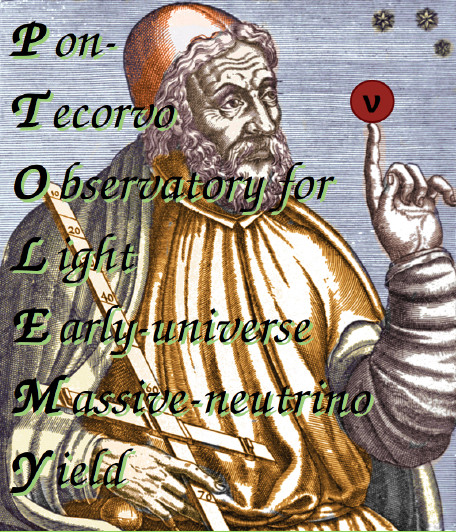Low Temperature Detectors for Neutrino Physics
University of Milano-Bicocca / INFN Milano Bicocca Group WEB page
Cosmological relic neutrinos are a fundamental ingredient of modern cosmology, but until today they escaped direct detection because of their extremely low interaction probability. Detecting the cosmological neutrino background is the goal of the PTOLEMY project. In PTOLEMY neutrinos are captured by tritium and electrons are emitted with a kinetic energy of a fraction of electronvolt (eV) above the tritium beta decay endpoint at 18keV. Electrons are then decelerated to few eVs, by removing a precisely known amount of kinetic energy with an time-varying electro-magnetic filter.
The medium term goals of PTOLEMY are the development and validation of its key technologies. Therefore the PTOLEMY collaboration is carrying out a number of focused R&D activities for the next three years (Phase-0) with the final goal to design a prototype demonstrator. The Demonstrator will be a small scale device integrating all technologies needed in order to investigate with an accuracy of 0.05 eV the endpoint of the decay spectrum of a weak tritium source. Building and running the Demonstrator (PTOLEMY Phase-1), will represent the key step towards the proposal of a full-scale experiment aiming at the relic neutrino detection (Phase-2).
Although the Demonstrator will use a mass of tritium which is too small to give a detectable signal of the CNB, it will be enough to turn the demonstrator in very sensitive neutrino mass experiment.
One of the most critical goals of the Demonstrator is the precise measurement of the energy of very low energy (<100eV) electrons. To this end, Transition Edge Sensor (TES) low temperature detectors are the most promising option, although they have never been exploited for a similar measurement.
The Cryogenic Laboratory is involved in the R&D to prove the capability of an array of TES microcalorimeters to match the PTOLEMY specifications. Other properties directly impacting the PTOLEMY feasibility and reach, such as the low energy secondary electron emission which influences the detector efficiency and spectral energy response will also be investigated. In the short term, the R&D will enable breakthroughs in direct neutrino mass measurements with impacts extending to surface physics and analysis, particle accelerators, nuclear fusion reactors, cancer radiotherapy, quantum communication, and more.
The main activities are:
- development and characterization of TES microcalorimeters in collaboration with Istituto Nazionale di Ricerca Metrologica (INRiM)
- TES characterization with optical photons and with low energy monoenergetic electron
- development of a low energy monoenergetic electron source based on photoemission
- development of TES microcalorimeters readout with microwave interrogated rf-SQUIDs and multiplexing
- modeling of low energy electron interactions with surfaces
PTOLEMY web page: https://ptolemy.lngs.infn.it
- M Betti, et al. Neutrino physics with the PTOLEMY project: Active neutrino properties and the light sterile case. Journal Of Cosmology And Astroparticle Physics 2019:047–047, 2019. URL, DOI
- M Rajteri, M Biasotti, M Faverzani, E Ferri, R Filippo, F Gatti, A Giachero, E Monticone, A Nucciotti and A Puiu. TES Microcalorimeters for PTOLEMY. Journal Of Low Temperature Physics 199:138–142, 2020. DOI



